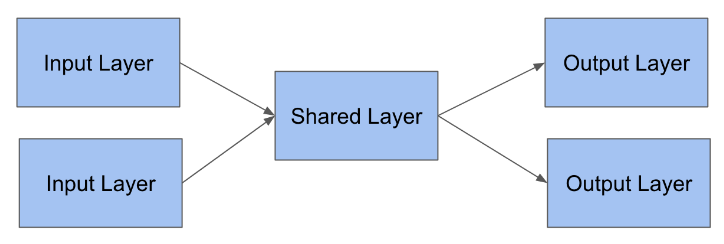Two Input Networks Using Categorical Embeddings, Shared Layers, and Merge Layers
In this chapter, you will build two-input networks that use categorical embeddings to represent high-cardinality data, shared layers to specify re-usable building blocks, and merge layers to join multiple inputs to a single output. By the end of this chapter, you will have the foundational building blocks for designing neural networks with complex data flows. This is the Summary of lecture "Advanced Deep Learning with Keras", via datacamp.
import tensorflow as tf
import numpy as np
import pandas as pd
import matplotlib.pyplot as plt
plt.rcParams['figure.figsize'] = (10, 8)
Define team lookup
Shared layers allow a model to use the same weight matrix for multiple steps. In this exercise, you will build a "team strength" layer that represents each team by a single number. You will use this number for both teams in the model. The model will learn a number for each team that works well both when the team is team_1 and when the team is team_2 in the input data.
games_season = pd.read_csv('./dataset/games_season.csv')
games_season.head()
from tensorflow.keras.layers import Embedding
# Count the unique number of teams
n_teams = np.unique(games_season['team_1']).shape[0]
# Create an embedding layer
team_lookup = Embedding(input_dim=n_teams,
output_dim=1,
input_length=1,
name='Team-Strength')
Define team model
The team strength lookup has three components: an input, an embedding layer, and a flatten layer that creates the output.
If you wrap these three layers in a model with an input and output, you can re-use that stack of three layers at multiple places.
Note again that the weights for all three layers will be shared everywhere we use them.
from tensorflow.keras.layers import Input, Flatten
from tensorflow.keras.models import Model
# Create an input layer for the team ID
teamid_in = Input(shape=(1, ))
# Lookup the input in the team strength embedding layer
strength_lookup = team_lookup(teamid_in)
# Flatten the output
strength_lookup_flat = Flatten()(strength_lookup)
# Combine the operations into a single, re-usable model
team_strength_model = Model(teamid_in, strength_lookup_flat, name='Team-Strength-Model')
team_in_1 = Input(shape=(1, ), name='Team-1-In')
# Separate input layer for team 2
team_in_2 = Input(shape=(1, ), name='Team-2-In')
Lookup both inputs in the same model
Now that you have a team strength model and an input layer for each team, you can lookup the team inputs in the shared team strength model. The two inputs will share the same weights.
In this dataset, you have 10,888 unique teams. You want to learn a strength rating for each team, such that if any pair of teams plays each other, you can predict the score, even if those two teams have never played before. Furthermore, you want the strength rating to be the same, regardless of whether the team is the home team or the away team.
team_1_strength = team_strength_model(team_in_1)
# Lookup team 2 in the team strength model
team_2_strength = team_strength_model(team_in_2)
Output layer using shared layer
Now that you've looked up how "strong" each team is, subtract the team strengths to determine which team is expected to win the game.
This is a bit like the seeds that the tournament committee uses, which are also a measure of team strength. But rather than using seed differences to predict score differences, you'll use the difference of your own team strength model to predict score differences.
The subtract layer will combine the weights from the two layers by subtracting them.
from tensorflow.keras.layers import Subtract
# Create a subtract layer using the inputs from the previous exercise
score_diff = Subtract()([team_1_strength, team_2_strength])
model = Model([team_in_1, team_in_2], score_diff)
# Compile the model
model.compile(optimizer='adam', loss='mean_absolute_error')
from tensorflow.keras.utils import plot_model
plot_model(model, to_file='../images/embedding_shared_merge_model.png')
data = plt.imread('../images/embedding_shared_merge_model.png')
plt.imshow(data);
input_1 = games_season['team_1']
# Get the team_2 column from the regular season data
input_2 = games_season['team_2']
# Fit the model to input 1 and 2, using score diff as a target
model.fit([input_1, input_2], games_season['score_diff'], epochs=1, batch_size=2048, validation_split=0.1, verbose=True);
Evaluate the model on the tournament test data
In this exercise, you will evaluate the model on this new dataset. This evaluation will tell you how well you can predict the tournament games, based on a model trained with the regular season data. This is interesting because many teams play each other in the tournament that did not play in the regular season, so this is a very good check that your model is not overfitting.
games_tourney = pd.read_csv('./dataset/games_tourney.csv')
games_tourney.head()
input_1 = games_tourney['team_1']
# Get team_2 from the tournament data
input_2 = games_tourney['team_2']
# Evaluate the model using these inputs
print(model.evaluate([input_1, input_2], games_tourney['score_diff'], verbose=False))

